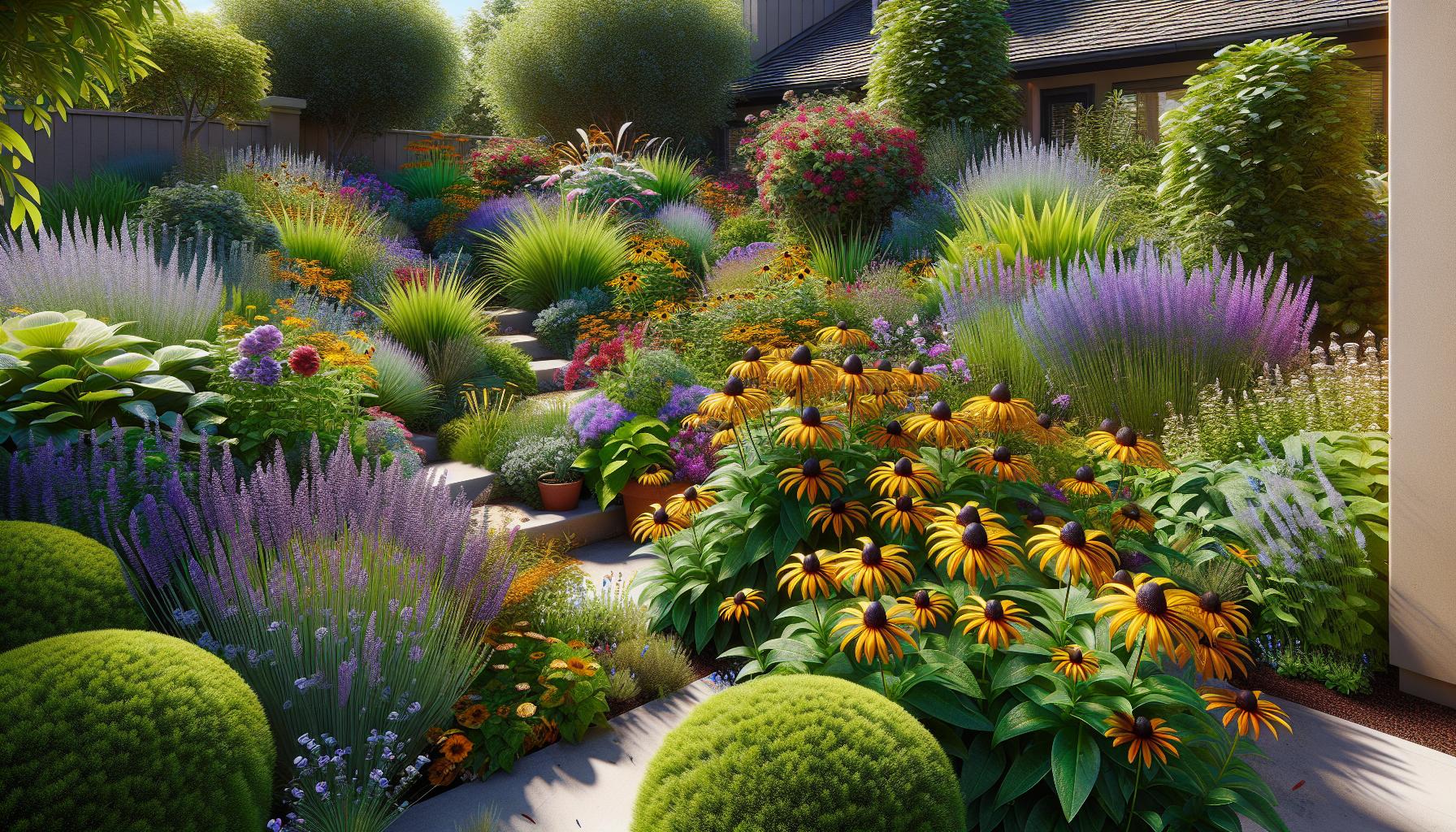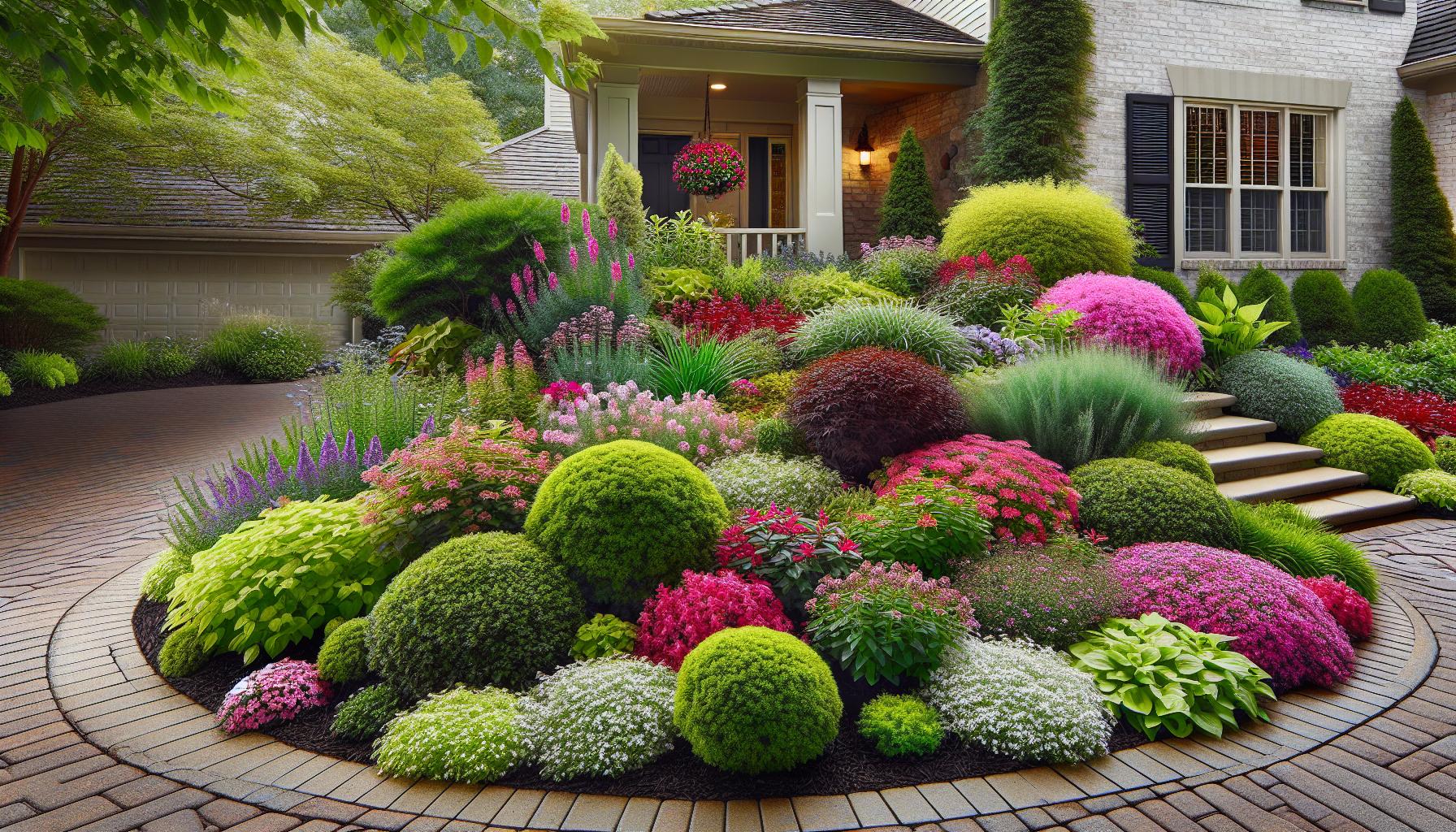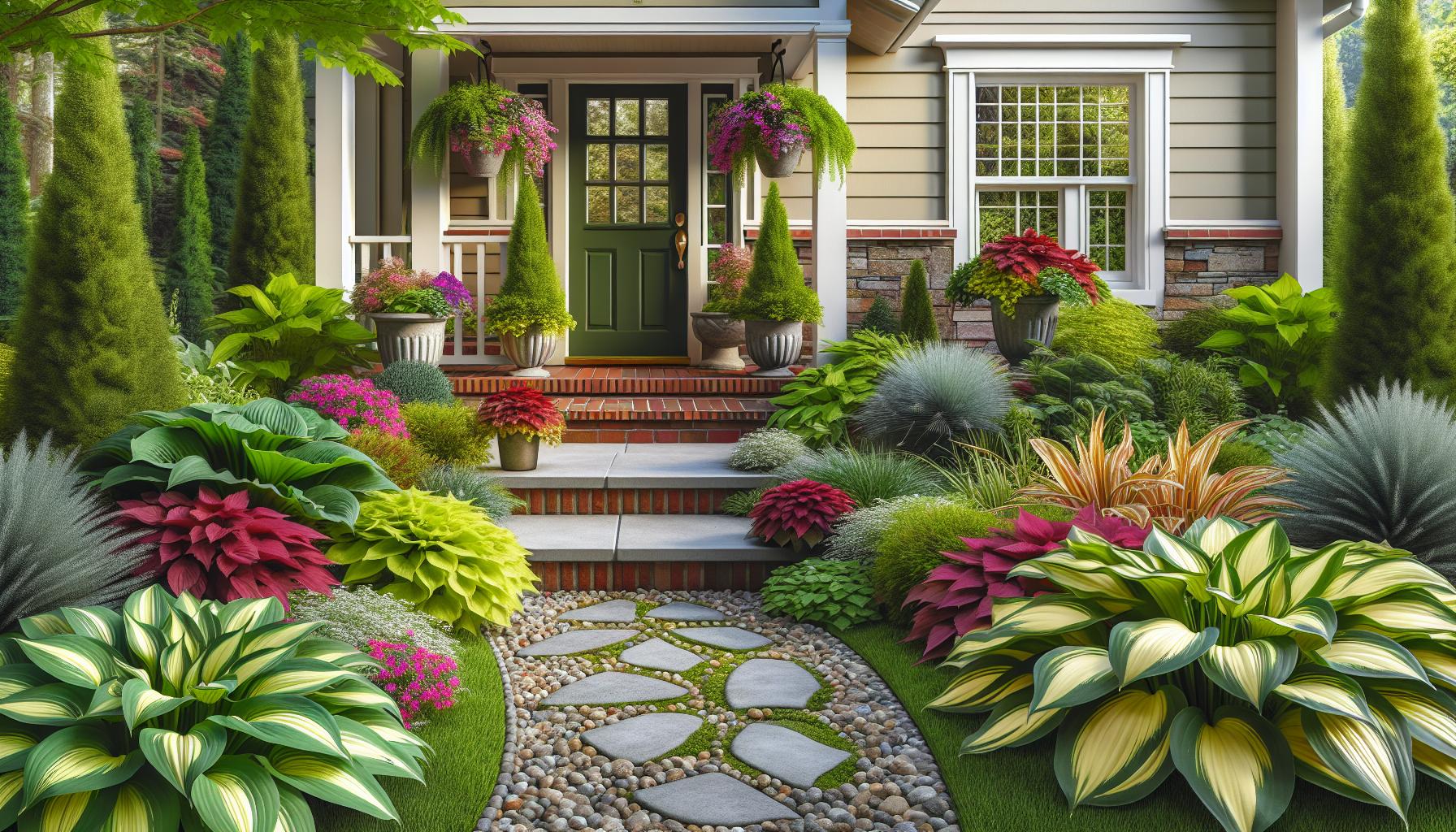I’ve discovered that creating an inviting front yard doesn’t need to be a time-consuming endeavor. Low-maintenance plants can transform your home’s curb appeal while requiring minimal effort to keep them looking their best. After years of experimenting with different varieties I’ve found the perfect balance between beauty and practicality.
Throughout my gardening journey I’ve learned that choosing the right plants for your front yard is crucial. These hardy selections will thrive with basic care allowing you to enjoy a gorgeous landscape without spending countless hours on upkeep. Whether you’re a busy professional a novice gardener or simply someone who wants a beautiful yard without the fuss I’ll share my top picks for low-maintenance plants that’ll make your home’s entrance look spectacular all year round.
Key Takeaways
- Choose low-maintenance evergreen shrubs like Boxwood, Japanese Holly, and Dwarf Yew as foundation plants for year-round curb appeal with minimal care requirements
- Incorporate drought-tolerant native plants such as Black-Eyed Susan, Purple Coneflower, and Russian Sage to reduce watering needs while maintaining visual interest
- Use ground covers like Creeping Thyme and Vinca Minor to suppress weeds and minimize maintenance while creating attractive carpeting effects
- Group plants with similar water needs together and install proper edging to create efficient maintenance zones and reduce ongoing care requirements
- Focus on seasonal maintenance tasks like spring cleanup, summer deadheading, and fall cutbacks to keep the landscape looking pristine throughout the year
Best Low Maintenance Plants for Curb Appeal
I’ve selected plants that deliver maximum visual impact with minimal maintenance requirements, creating an attractive front yard display that stands strong through multiple seasons.
Evergreen Shrubs and Bushes
Evergreen shrubs form the backbone of my low-maintenance landscaping with their year-round foliage. My top picks include:
- Boxwood (Buxus): Maintains dense, green foliage in zones 5-9
- Japanese Holly (Ilex crenata): Grows 3-10 feet tall in zones 5-8
- Dwarf Yew (Taxus): Thrives in partial shade zones 4-7
- Mountain Laurel (Kalmia latifolia): Features spring blooms in zones 4-9
These shrubs require:
- Pruning: 1-2 times per year
- Watering: Once weekly in dry periods
- Fertilizing: Once annually in spring
Ornamental Grasses
Ornamental grasses add movement texture to my landscape design with minimal care requirements. My recommended varieties include:
- Fountain Grass (Pennisetum): Reaches 2-3 feet in zones 5-9
- Blue Fescue (Festuca glauca): Grows in compact 6-12 inch mounds
- Maiden Grass (Miscanthus): Creates privacy screens up to 6 feet tall
- Little Bluestem (Schizachyrium): Offers bronze fall color in zones 3-9
| Task | Frequency | Season |
|---|---|---|
| Cutting back | Once | Late winter |
| Division | Every 3-4 years | Spring |
| Watering | Bi-weekly | Growing season |
Drought-Tolerant Front Yard Plants

I’ve discovered that drought-tolerant plants create stunning front yard displays while minimizing water consumption and maintenance requirements. These resilient plants thrive in challenging conditions, making them perfect for areas with water restrictions or properties with limited irrigation systems.
Native Plants for Easy Care
Native drought-resistant plants have evolved to flourish in local climate conditions with minimal intervention. Here are my top native selections:
- Black-Eyed Susan: Produces vibrant yellow blooms from June through September
- Yarrow: Features flat-topped flower clusters in white, yellow or pink shades
- Purple Coneflower: Attracts butterflies with its long-lasting summer blooms
- Little Bluestem: Displays blue-green foliage that turns copper-red in fall
- Butterfly Weed: Offers orange flowers that support monarch butterflies
Heat-Resistant Perennials
These sun-loving perennials maintain their beauty even during intense summer heat:
| Plant Name | Bloom Time | Height (inches) | Sun Exposure |
|---|---|---|---|
| Lantana | Spring-Fall | 24-36 | Full Sun |
| Russian Sage | Summer-Fall | 36-48 | Full Sun |
| Sedum | Late Summer | 18-24 | Full Sun |
| Lavender | Summer | 24-36 | Full Sun |
| Blanket Flower | Spring-Fall | 12-24 | Full Sun |
Each of these perennials requires watering only during their establishment period in the first season. I’ve found they thrive in well-draining soil with 6+ hours of direct sunlight. These plants maintain their structure through extreme temperatures while providing continuous color from spring through fall.
Ground Cover Options for Front Gardens

Ground covers provide essential soil protection while reducing maintenance needs in front gardens. These low-growing plants create a living carpet that suppresses weeds and adds visual interest to the landscape.
Creeping Plants and Spreaders
I’ve found several creeping plants that excel at covering bare spots with minimal care:
- Creeping Thyme spreads 12-18 inches annually with fragrant foliage
- Japanese Pachysandra forms dense 6-inch mats in shaded areas
- Creeping Juniper extends 6-8 feet wide in sunny locations
- Vinca Minor produces purple blooms while spreading 3-4 feet yearly
- Creeping Phlox cascades over walls with spring flowers in pink purple or white
| Plant Name | Spread Rate | Sun Requirement | Height |
|---|---|---|---|
| Creeping Thyme | 12-18″ per year | Full sun | 2-3″ |
| Pachysandra | 6-12″ per year | Shade/Part shade | 6-8″ |
| Creeping Juniper | 6-8′ wide | Full sun | 6-8″ |
| Vinca Minor | 3-4′ per year | Part shade/Shade | 4-6″ |
| Creeping Phlox | 2′ per year | Full sun | 4-6″ |
Low-Growing Flowers
I rely on these compact flowering plants to create colorful carpets in my front garden:
- Dianthus forms 6-inch mounds with pink blooms from spring through fall
- Iberis produces white flower clusters on 8-inch stems starting in early spring
- Ajuga develops 4-inch blue flower spikes above bronze-purple foliage
- Sedum spurium spreads quickly with clusters of pink flowers in summer
- Mazus reptans creates a 2-inch mat with purple blooms in partial shade
These ground covers need trimming only once annually to maintain their shape. I water established plants during extended dry periods and apply a slow-release fertilizer in early spring.
Container Plants for Front Entrances

I’ve found that container plants create welcoming focal points at front entrances while offering flexibility in design. These selections add personality to entryways through strategic placement in decorative pots.
Weather-Hardy Potted Plants
My top picks for weather-resistant container plants include:
- Hosta thrives in shaded entryways with 3 waterings per month
- Japanese Forest Grass maintains green foliage through temperature fluctuations of 20-85°F
- Heuchera displays colorful leaves in purple bronze or lime green year-round
- Blue Star Juniper grows 2-3 feet tall with silvery-blue needles resistant to winter burn
- Dwarf Alberta Spruce reaches 4-5 feet in containers with minimal pruning
| Plant Name | Sun Exposure | Water Needs | Temperature Range |
|---|---|---|---|
| Hosta | Shade/Part Sun | Monthly | 30-85°F |
| Japanese Forest Grass | Part Shade | Bi-weekly | 20-85°F |
| Heuchera | Part Sun | Weekly | 25-85°F |
| Blue Star Juniper | Full Sun | Bi-weekly | -30-90°F |
| Dwarf Alberta Spruce | Full Sun | Weekly | -30-80°F |
These plants withstand temperature extremes from -30°F to 90°F while maintaining their appearance. Each variety requires minimal maintenance with 2-3 seasonal fertilizer applications using a balanced 10-10-10 formula.
Design Tips for a Maintenance-Free Front Yard
Group Plants by Water Needs
I organize plants with similar water requirements together to create efficient watering zones. This hydrozoning approach reduces maintenance time by:
- Placing drought-tolerant plants in one area
- Grouping moderate-water plants separately
- Installing efficient drip irrigation for each zone
Create Defined Borders
Clean edges between garden beds eliminate constant edging maintenance through:
- Installing permanent metal or stone edging
- Using concrete mow strips between lawn and beds
- Adding wide pathways to separate planting areas
Optimize Planting Density
I maximize ground coverage while minimizing maintenance by:
- Spacing plants at 75% of their mature width
- Creating living mulch through dense plantings
- Installing larger specimens in groups of 3-5
Add Hardscaping Elements
Strategic hardscaping reduces maintenance areas through:
- Installing gravel paths between planting beds
- Creating stone or paver gathering spaces
- Using decorative rocks as focal points
Mulch Management
I maintain consistent mulch layers to:
- Apply 2-3 inches of organic mulch in beds
- Use pine straw under acid-loving plants
- Place river rocks in drought-prone areas
- Creating broad sweeps of single plant varieties
- Limiting plant types to 5-7 species
- Designing curved beds for easier mowing
| Design Element | Maintenance Reduction | Installation Cost |
|---|---|---|
| Metal Edging | 80% less edging time | $8-12 per foot |
| Drip Irrigation | 60% water savings | $2-4 per sq ft |
| Hardscaping | 90% less weeding | $15-30 per sq ft |
| Dense Planting | 70% less mulching | $10-20 per plant |
| Professional Edging | 85% maintenance reduction | $5-8 per linear foot |
Seasonal Care and Basic Maintenance
Spring Tasks
I perform these essential spring maintenance tasks to keep my low-maintenance front yard thriving:
- Remove winter mulch debris in early March
- Trim dead foliage from ornamental grasses before new growth emerges
- Apply slow-release granular fertilizer in April
- Add 2 inches of fresh mulch around plants in May
- Prune spring-flowering shrubs immediately after blooms fade
Summer Care
My summer maintenance routine focuses on these minimal tasks:
- Water deeply once weekly during dry spells
- Remove spent blooms from perennials monthly
- Spot-check for insect damage bi-weekly
- Maintain 3-inch mulch depth throughout beds
- Trim wayward branches from evergreen shrubs in June
Fall Preparation
I complete these autumn tasks to prepare plants for winter:
- Cut back perennial foliage in October
- Remove fallen leaves from ground covers weekly
- Apply winter mulch in November
- Reduce watering frequency by 50%
- Plant spring-flowering bulbs in September
- Brush heavy snow off evergreen branches
- Check mulch levels monthly
- Monitor for winter burn on broadleaf evergreens
- Apply anti-desiccant spray to evergreens in December
- Avoid salt exposure near foundation plantings
| Season | Watering Frequency | Fertilization | Primary Tasks |
|---|---|---|---|
| Spring | Weekly | April | Cleanup, mulching |
| Summer | Weekly-biweekly | None | Deadheading, pruning |
| Fall | Biweekly | None | Cutback, leaf removal |
| Winter | Monthly | None | Snow removal, protection |
Conclusion
I’ve found that creating a beautiful front yard doesn’t have to mean endless hours of maintenance. With the right plant selection and smart design strategies you can achieve a stunning landscape that practically takes care of itself.
By incorporating these low-maintenance plants and following the seasonal care guidelines I’ve shared you’ll spend less time working in your garden and more time enjoying it. These hardy varieties will reward you with year-round beauty while demanding minimal attention.
Remember that a low-maintenance front yard is all about working smarter not harder. Choose plants that match your climate pair them thoughtfully and let nature do most of the work. Your dream of a beautiful yet easy-care front yard is absolutely achievable.




